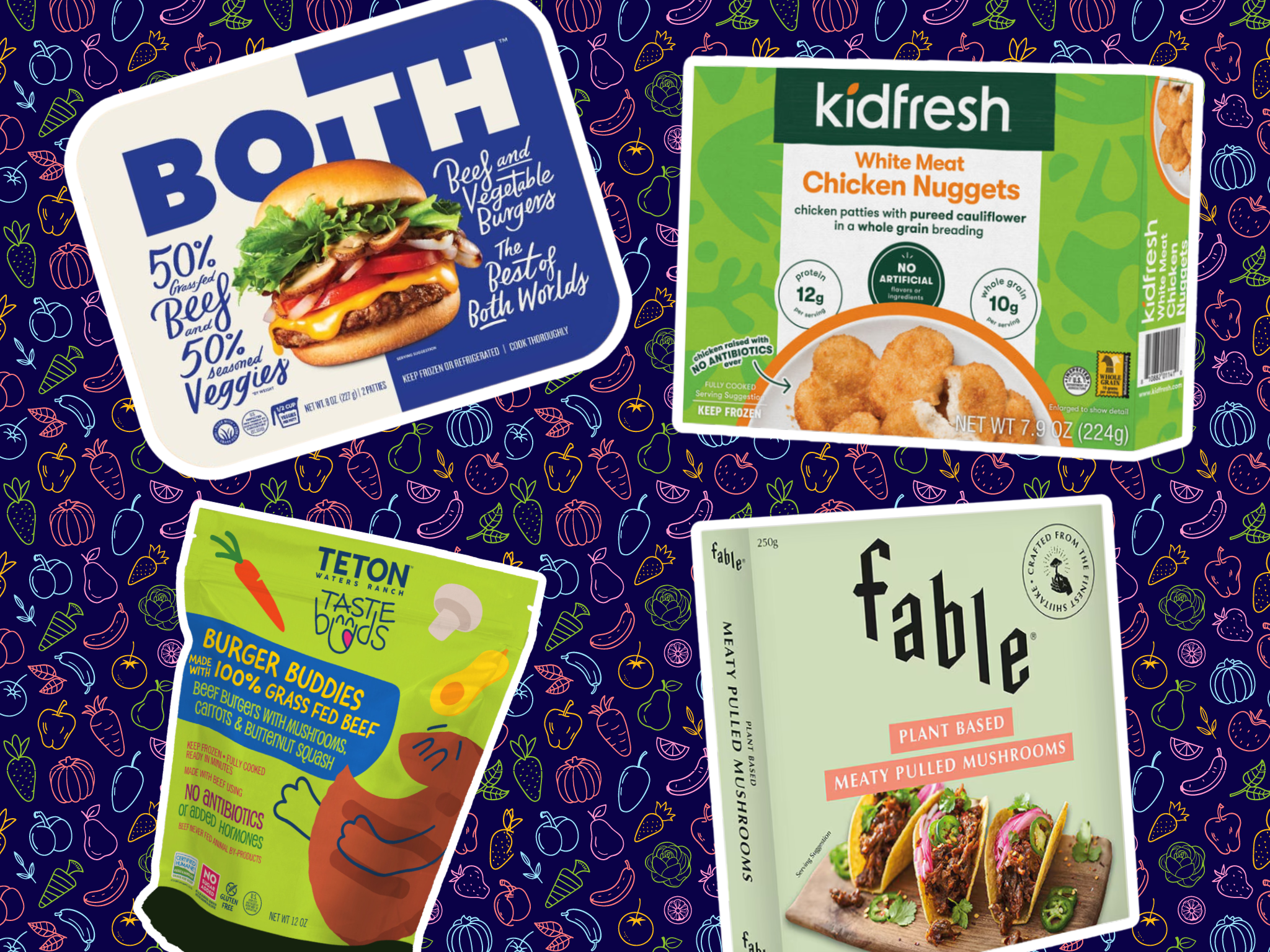Americans Like Blended Meat Burgers & Nuggets More Than Their Bestselling 100% Animal Counterparts
9 Mins Read
In a comprehensive survey about blended meat, Americans were found to prefer half-meat, half-plant burgers and nuggets more than the market-leading, fully animal-derived products.
People prefer the taste of blended meat over most plant-based analogues, as well as some 100% animal meat products, a blind taste test has shown.
Nectar, a new initiative focused on taste-based protein transition, convened 1,192 meat-eaters from across America to analyse their views on blended meat products, which combine conventional meat with plant-based proteins and ingredients.
The Future of the Industry 2024: Plant-Rich Meat report contains insights from sensory panels where participants analysed over 50 sensory attributes for 22 blended meat products across nine categories: burgers, steaks, hot dogs, pork sausages, beef and pork meatballs, chicken sausages, chicken meatballs, chicken nuggets, and unbreaded chicken patties.
Two-thirds of respondents (67%) expressed interest in buying blended meats. While this was (expectedly) much lower than the 90% who would buy conventional meat – given this was a poll of omnivores – fewer people said the same about plant-based analogues (57%).
The results mirror those of Nectar’s Taste of the Industry report from June, where the Both Burger by 50/50 Foods outperformed plant-based meat on taste, and was the only alternative patty that came within one point in average liking of the conventional burger.
50/50 Foods was recognised as one of the leading taste performers in the blended meat category, alongside Fusion Foods’ Duo burgers, Teton Waters Ranch’s Veggie Blends, and Fable Foods, which announced its move into blended meat today.
Teton Waters Ranch was also the leader in the “plant-rich” beef/pork meatball category, while Kidfresh was the top performer for chicken meatballs and nuggets, and Grateful Eats in the chicken patty segment.
Blended meats have been recognised by many in the food industry as a pathway to accelerate emissions reduction from meat consumption in the short term, especially at a time when meat intake is said to increase and plant-based meat sales have suffered. But for greater consumer uptake, several challenges lie ahead.
Blended burgers and nuggets taste better

Nearly three-quarters (74%) of Americans were interested or extremely interested in the concept of blended meats (and only 4% showed no intrigue). These products were received better than conventional products in two categories: burgers and chicken nuggets.
The leading plant-rich burger was liked by 56% and nugget by 58%, higher than the 42% and 47% of people who liked the 100% animal products. Even the average blended burgers (42%) and nuggets (51%) were found to be on par or slightly better. In contrast, only 36% liked plant-based burgers, while a similar number of people liked vegan nuggets (47%).
“These two categories performed well for different reasons,” Nectar director Caroline Catto tells Green Queen. “For burgers, I think it was because burgers – like sausages or meatballs – are a format that consumers understand as historically ‘blended’ (includes seasonings, onions, etc.),” she says.
“For the burgers we tested, I also think it was because these products were mostly blended with premium ingredients like caramelised onions, shiitake mushrooms, etc. that are umami and delicious in their own right.”
The report found that blended meat products had a better beef flavour than 100% beef, were juicier, and were adjudged to have a superior look and seared exterior. In fact, conventional burgers were the worst-performing products when it came to savoury flavours, with only 29% of respondents associating them with these tasting notes, versus 32% doing so for plant-based and 38% for blended burgers.

Meanwhile, blended chicken nuggets (you know, like the ones McDonald’s sells) were found to hold together better and be much crunchier than conventional nuggets, and performed nearly as well as 100% chicken nuggets on savoury and chicken flavours.
“For nuggets, this was the only breaded category we tested, and I think we’re seeing that breaded products continue to perform highly across plant-based and plant-rich products,” Catto says.
Vegetables > meat analogues
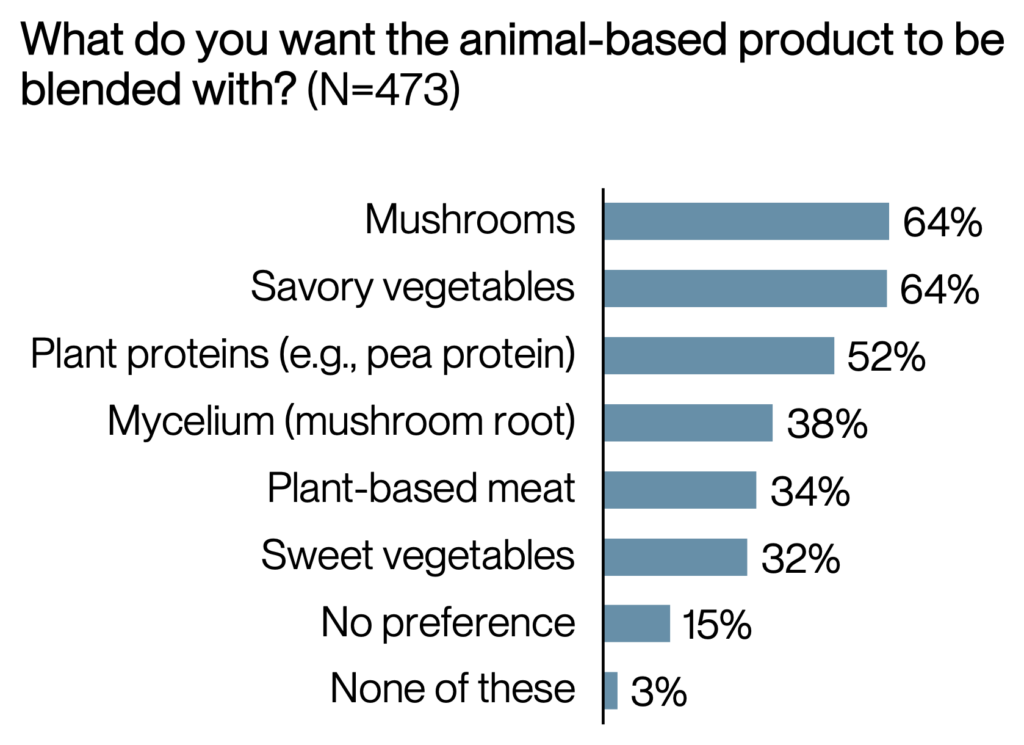
Despite the sensory dominance of burgers and nuggets, when asked what plant-rich products appeal to them the most in theory, 79% of Americans said meatballs, followed by sausages (75%) and burgers (73%). On the other end of the spectrum lie steak and cold cuts, which appealed to only 19% and 18%, respectively.
Interestingly, a majority (60%) of respondents said they prefer a 50-50 balance of plant and animal ingredients, while another 30% preferred a mix that contains around 90-95% of animal meat. And as for what these plant-based ingredients could entail mushroom and savoury vegetables (64%) each were much more attractive than plant proteins like pea (52%), mycelium (38%), or plant-based meat (34%).
“This speaks to the importance of consumer education and making sure ingredient labels include things that consumers are either familiar with and can understand, or if not, that companies go above and beyond to help customers understand what their products are made of,” says Catto.
“For blended meat companies, this points to an opportunity to lean into whole-food plant-based ingredients when creating blends,” she adds. “For plant-based alternative meat companies, the focus needs to continue to be on creating taste-forward options that replicate the experience of real meat and exceed consumer expectations on taste, price, and health.”
Motivations, barriers, and entry points
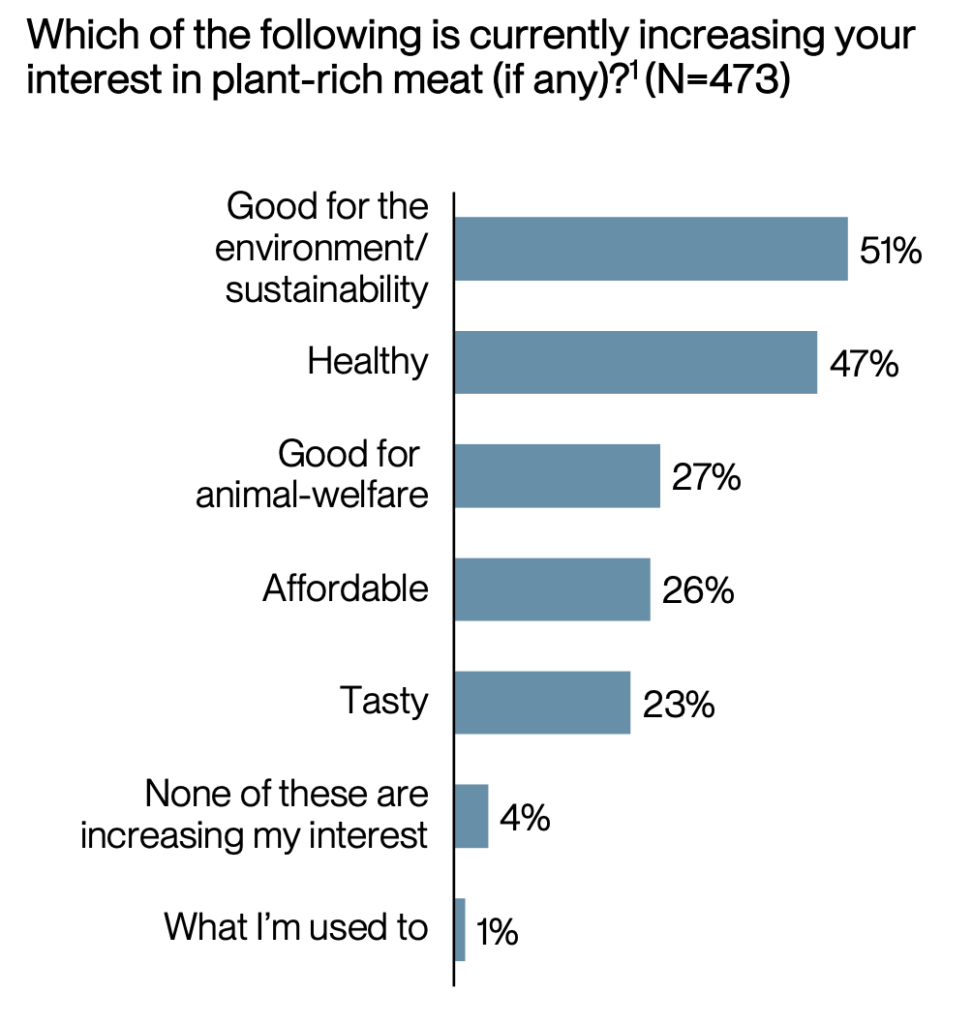
Plant-based meat makers have been moving away from the climate-centric messaging that they based their brands on for so long because that argument is no longer moving the needle. Instead, consumers seem more concerned with health, nutrition, taste and price.
But things seem different when it comes to blended meat – environmental sustainability was the top interest driver for these products, cited by 51%. Health (47%) follows closely behind.
“Participants in this study recognised that reducing meat consumption has positive sustainability outcomes,” explains Catto. “Consumers’ understanding of how diet connects to sustainability has grown significantly over the past several years – however, brands must still deliver the personal benefits to consumers (taste, price, and health) in order to drive demand.”

The factors holding most Americans back were affordability (45%) and flavour (43%), while another 27% said they were not familiar with the products. That said, nearly a quarter (24%) said they were willing to pay more for blended meat products, while another 43% were happy to buy them if they were priced the same as conventional meat. This suggests that companies should aim for price parity, according to Catto.
“While consumers may be willing to pay a slight premium, the vast majority of flexitarian consumers expect these products to be the same as animal-based meat, or slightly cheaper since they contain half the amount of meat,” she says. “Once ‘taste’ has been solved, price will be the next big hurdle for these companies so they should aim for parity from the start.”
She continues: “In Europe, we’re seeing some white-label plant-based and plant-rich products that are being sold for less than their animal analogues. In these cases, retailers are leading the charge to make these options more affordable and more approachable defaults for consumers.”
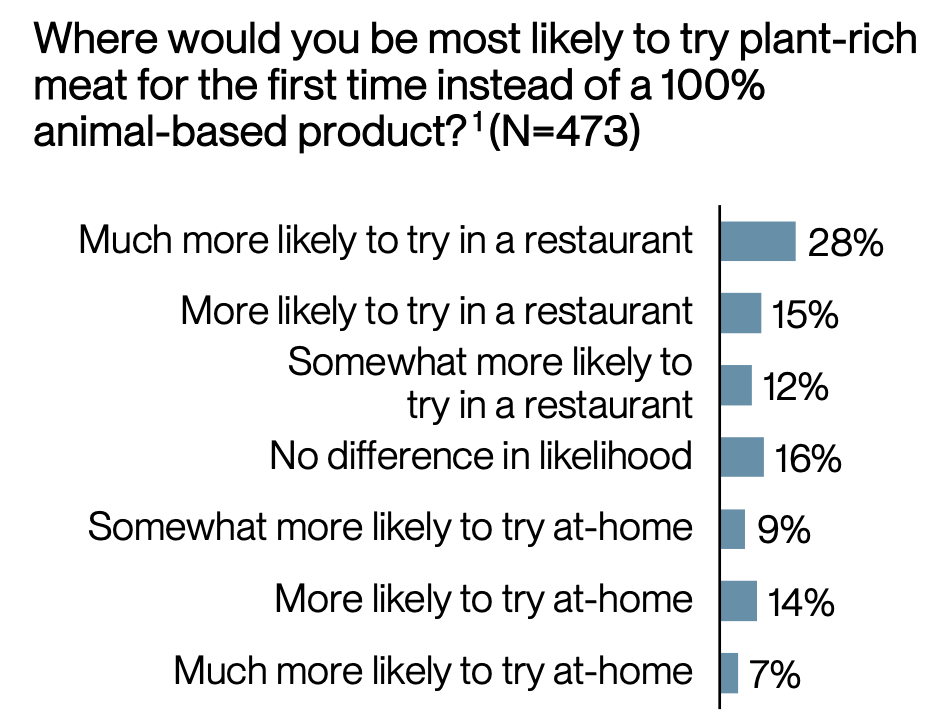
Moreover, 55% of Americans said they were more likely to try these products in restaurants instead of at home. “The barrier to entry is lower in foodservice,” suggests Catto. “Consumers are more likely to try something novel if they don’t have to cook it themselves or risk cooking something they are unfamiliar with.
“Foodservice presents a real opportunity to show consumers how delicious plant-rich products can be in different menu options and hopefully drive more at-home consumption as familiarity grows. I see this as very akin to why Impossible initially sold into restaurants and foodservice as a way to socialise the products before launching in retail.”
The roadblocks on the path to mainstream adoption
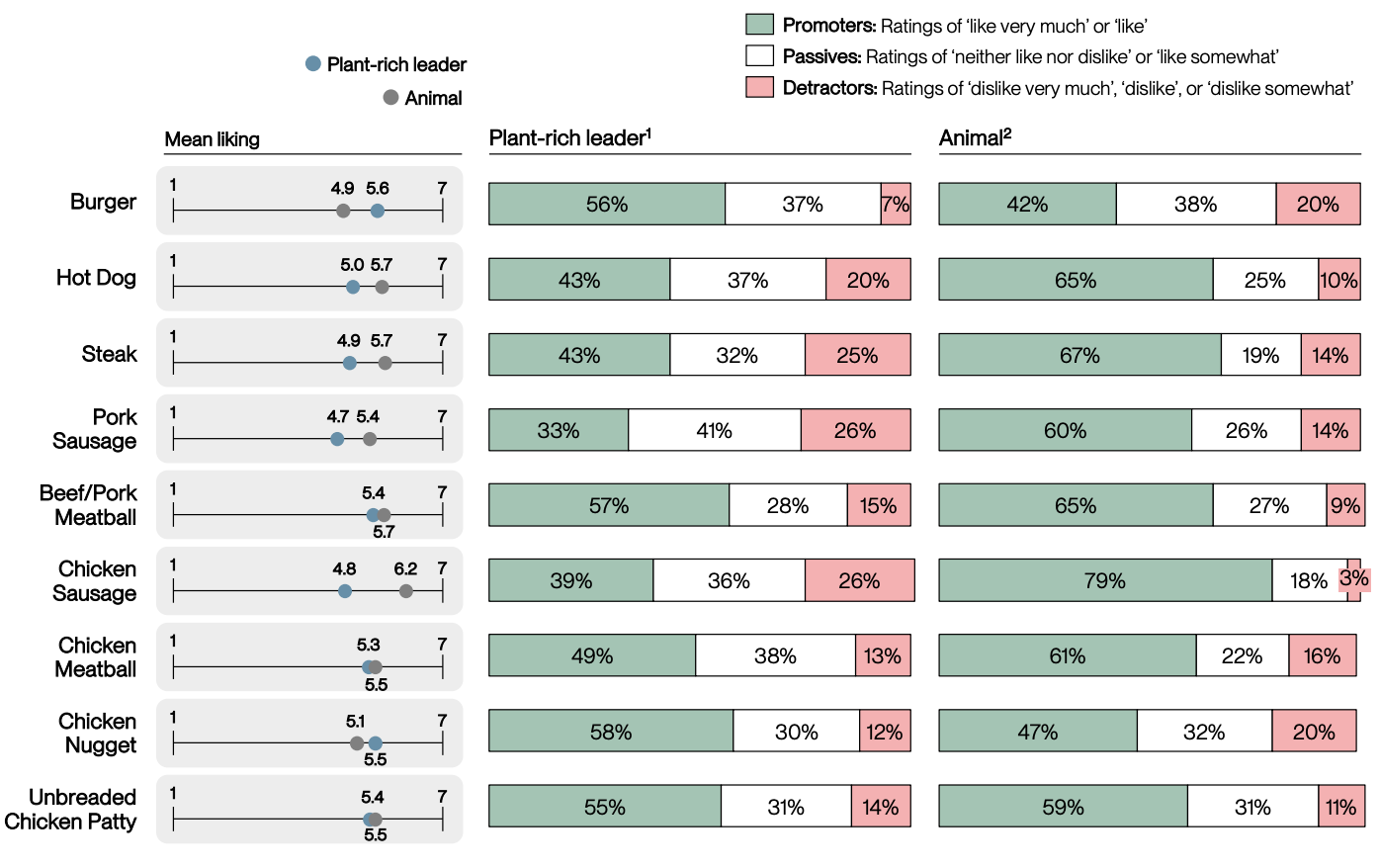
Despite the potential interest, blended meat products still trailed behind 100% animal meat in seven out of the nine product segments. “This tells us a few things,” says Catto.
First, further R&D is needed for the blended meat category to hit the mainstream. Secondly, and in that vein, the plant-rich category does have mainstream taste potential, as evidenced by the leading burger and nugget products.
Finally, just as hybrid cars are paving the way to full EV adoption, blended meat “offers a practical solution consumers can adopt today to curb their meat consumption on the way to full plant-based adoption”.
This is the hope of the companies whose products were involved in the taste test. In the last 12 months, the blended meat sector has moved faster than it ever has – the Both Burger is in Disneyland, Mush Foods’s 50Cut Burger is now being sold by Pat LaFrieda, Harvest B is doing blended meat too, and Quorn (one of the largest meat-free companies globally) is offering its mycoprotein to British hospitals for blended solutions.
Several challenges lie ahead. “The first is determining who is the core audience for these products, and once that’s been established, how do you reach that audience and market to those consumers appropriately,” notes Catto.
Food Systems Innovation, the parent organisation of Nectar, has hired Tim Dale as a category innovation director to tackle this research, looking into consumer insights, nomenclature and labelling, and the optimal blend ratios to set to avoid greenwashing.
“Blended products still have work to do to surpass animal-based products in taste, as well as additional marketing challenges that will determine the scale of consumer adoption.”
Where does this leave plant-based companies?
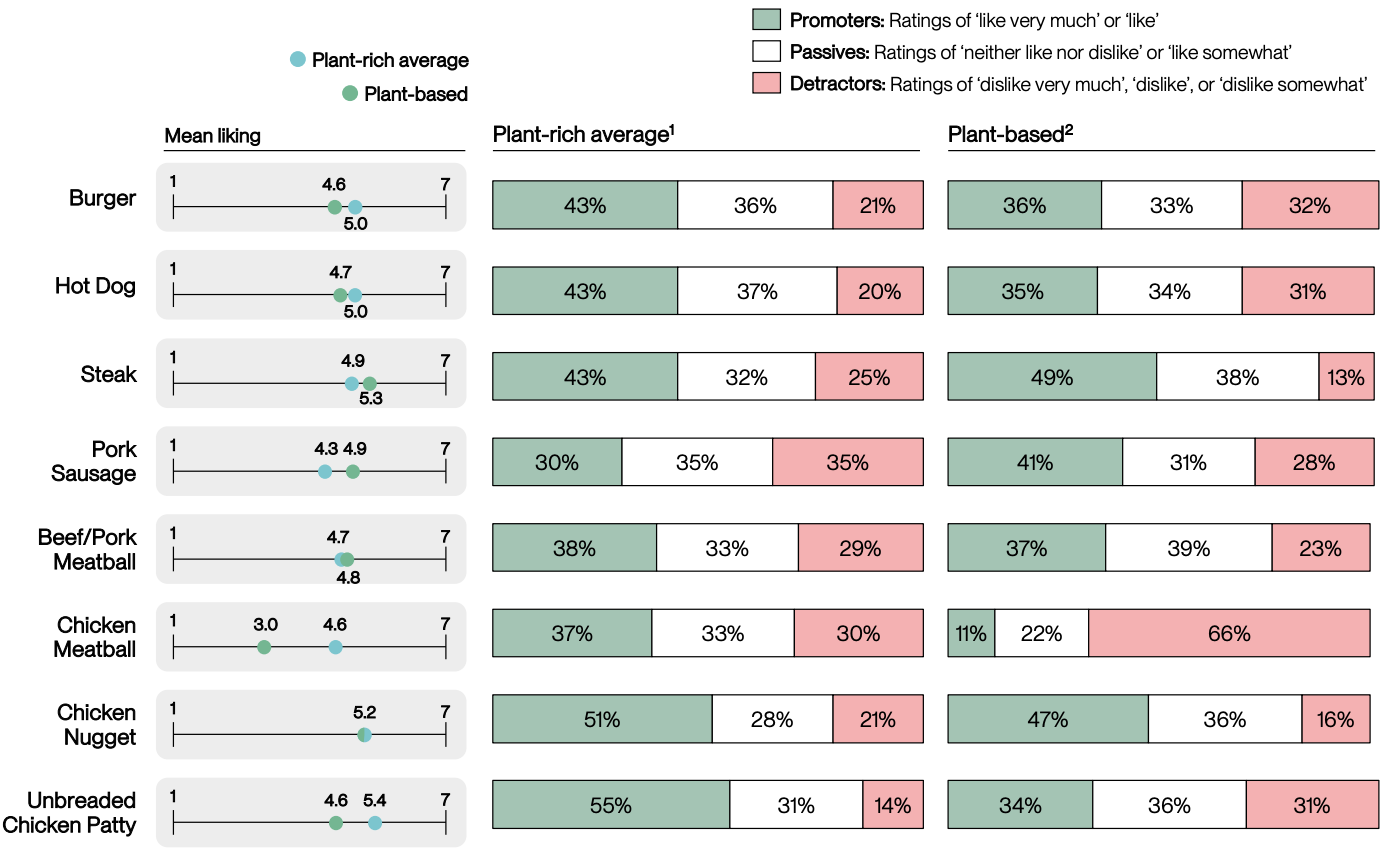
Leading blended meat products outperformed plant-based analogues in six out of eight categories (there were no vegan chicken sausage products tested). But when it comes to the average blended meat offering, leading plant-based products had a higher mean liking in four of the eight categories.
“The meat category is large and alternative proteins are just scratching the surface (currently at about 2% of total market share). There’s room for both plant-rich meat and plant-based products to coexist and possible that there will be learnings and synergies between them,” says Catto.
Nectar is now working on its 2025 Taste of the Industry report, where it will test 150 plant-based meat products across 15 categories. Catto suggests that the main takeaways for vegan meat makers from the blended meat poll are similar to those from this year’s Taste of the Industry report. “More R&D is needed if plant-based companies want to win over omnivore consumers,” she explains.
“They need to lean into bolder product profiles that more closely mimic or exceed the taste and experience of animal-based meat. This will require further investment in sensory research as well as development of novel ingredients and technologies.”

